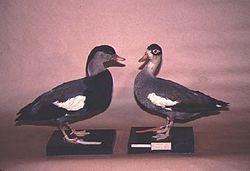Crested shelduck
| Crested shelduck | |
|---|---|
 |
|
| Male (left) and female specimens, Kuroda collection, Tokyo, Japan | |
| Scientific classification | |
| Kingdom: | Animalia |
| Phylum: | Chordata |
| Class: | Aves |
| Order: | Anseriformes |
| Family: | Anatidae |
| Subfamily: | Tadorninae |
| Genus: | Tadorna |
| Species: | T. cristata |
| Binomial name | |
|
Tadorna cristata (Kuroda, 1917) |
|
 |
|
| Area from which the crested shelduck is known; current range unknown | |
| Synonyms | |
|
|
The crested shelduck or Korean crested shelduck (Tadorna cristata) is a species of bird in the family Anatidae. It is critically endangered and may be extinct. The male crested shelduck has a greenish-black crown, breast, primaries, and tail, while the rest of its face, chin, and throat are brownish black. The male's belly, undertail coverts, and flanks are a dark grey with black striations. The upper wing coverts are white, while its speculum is an iridescent green. The female has a white eye ring, black crest, white face, chin, throat, neck, and uppers wing coverts and a dark brown body with white striations. Additionally, both sexes have a distinctive green tuft of feathers protruding from the head.
Very little is known about this bird because of the limited number of observations of this species. It apparently breeds in Korea and eastern Russia and is probably a relict species that had a wider distribution in prehistoric times. Some think that this species is extinct, although occasional sightings are reported, including a number of recent reports from the interior wetlands of China. Due to the persistent reports of the species' survival, it is listed as critically endangered. However, the crested shelduck has not been definitively sighted since 1964.
The crested shelduck was initially collected in April 1877 near , Russia. However, it was not described until 1890 when the English zoologist Philip Lutley Sclater decided that the specimen was a possible hybrid between the ruddy shelduck (Tadorna ferruginea) and falcated duck (Anas falcata). Around 1913, a pair was collected in Korea, and the male was presented to Japanese ornithologist Nagamichi Kuroda. Kuroda noted that the plumage of the specimens was not definitively intermediate between Sclater's suggested parents of the alleged hybrid. Another female was collected and given to Kuroda in 1916, and supported by three specimens of a bird which was clearly not a hybrid and a historical record of the species in Japan, Kuroda described this bird as Pseudotadorna cristata in 1917. The 1916 female was designated the holotype and preserved with the male in Kuroda's collection. A member of the family Anatidae, this species was considered distinct enough to merit its own genus by Kuroda, but is now placed in the genus Tadorna, which includes six other species of Old World shelducks. The genus name Tadorna comes from the Celtic word tadorne and means "pied waterfowl", essentially the same as the English "shelduck". The specific epithet, cristata, comes from the Latin word for crested. The species' common name is derived from the tuft of green feathers from the shelduck's head. This species is also known as the Korean crested shelduck, Korean sheldrake, and Korean Mandarin.
...
Wikipedia

